On the day this week that Mexico imposed new measures to shut down migrant crossings at its southern border, some 1,200 made the trip at a single remote jungle outpost without showing a document to anyone.
A man who helped board the migrants for the five-minute boat ride Sunday from Guatemala across the Usumacinta River knew the count because each one received a ticket.
Mexico wants to again appear cooperative, as in 2019 when, faced with tariffs from then-President Donald Trump, it deployed its newly created National Guard to slow the flow of migrants from Central America.
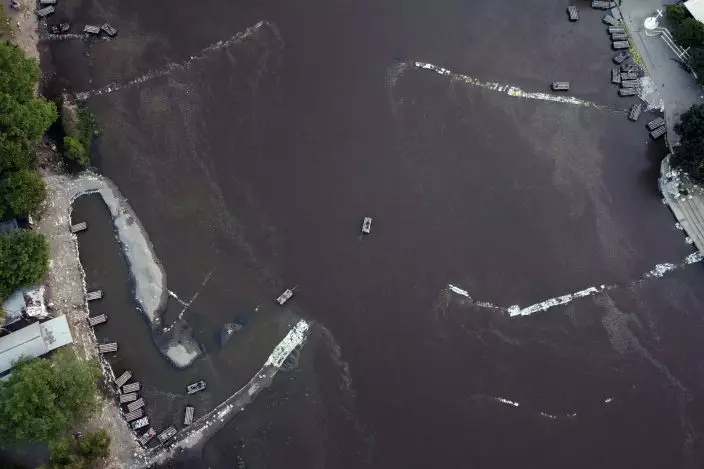
People travel across the Suchiate River, the natural border between Guatemala, right, and Mexico, left, as Mexican immigration agents enforce limits on all but essential travel at its shared border near Ciudad Hidalgo, Mexico, Monday, March 22, 2021. Mexico wants again to appear cooperative like it was in 2019 when under threat of tariffs from then-President Donald Trump it deployed soldiers to slow down the flow of migrants from Central America, but the reality here is business as usual as entire communities live off migrants headed north for reasons now familiar: violence, an inability to support their families, the devastation wrought by two major hurricanes that hit Central America in November and egged on by rampant misinformation. (AP PhotoEduardo Verdugo)
But the reality is it's business as usual, with entire communities making a living off the passing migrants.
Their reasons for heading north are familiar: violence, an inability to support their families, the devastation wrought by two major hurricanes in November and egged on by rampant misinformation.
Among those crossing Sunday was Yuri Gabriela Ponce, a 30-year-old mother from Tegucigalpa, Honduras, along with her husband and three children, ages 2, 5 and 9.
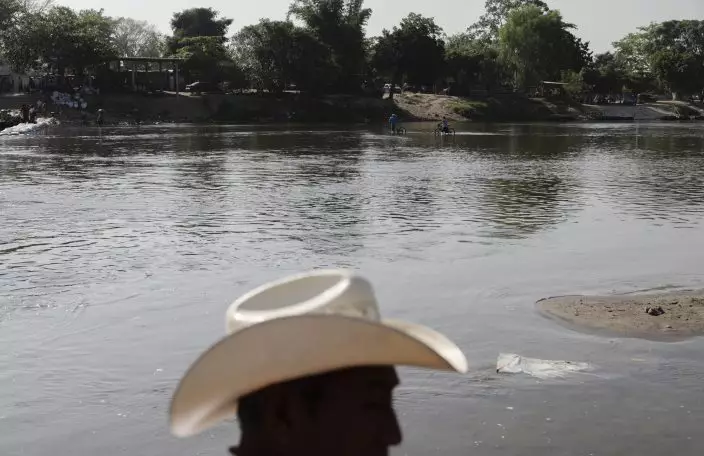
People travel across the Suchiate River from Mexico to Guatemala, the natural border between Guatemala and Mexico, as Mexican immigration agents enforce limits on all but essential travel at its shared border near Ciudad Hidalgo, Mexico, Sunday, March 21, 2021. Mexico wants again to appear cooperative like it was in 2019, when under threat of tariffs from then-President Donald Trump it deployed soldiers to slow down the flow of migrants from Central America, but the reality here is business as usual as entire communities live off migrants headed north for reasons now familiar: violence, an inability to support their families, the devastation wrought by two major hurricanes that hit Central America in November and egged on by rampant misinformation.(AP PhotoEduardo Verdugo)
Now, having reached Mexico, they were uncertain how to proceed. As she rested Wednesday in the shade at a crossroads just north of the border, she worried about what would come next.
“They told us that farther ahead there is a checkpoint and we don’t know what to do,” Ponce said. “I hope that with the children they help us.”
The family left Honduras after Ponce’s husband lost his construction job and was unable to find another. They left two older children with relatives.
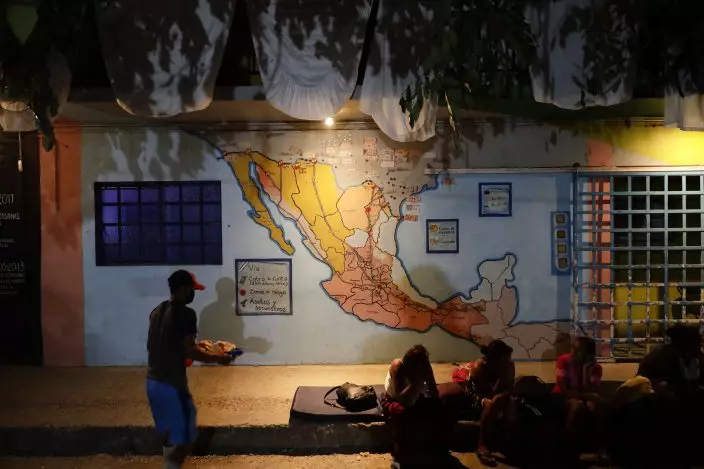
Migrants wait to eat on the sidewalk outside the "La 72" migrant shelter in Tenosique, Tabasco state, Mexico, Wednesday, March 24, 2021. Mexico wants again to appear cooperative like it was in 2019 when under threat of tariffs from then-President Donald Trump it deployed soldiers to slow down the flow of migrants from Central America, but the reality here is business as usual as entire communities live off migrants headed north for reasons now familiar: violence, an inability to support their families, the devastation wrought by two major hurricanes that hit Central America in November and egged on by rampant misinformation. (AP PhotoEduardo Verdugo)
Initially they planned to cross into Mexico much farther south, but heard a rumor that criminals were stealing children and killing parents there. So they reversed course and came to this remote jungle outpost instead.
In the riverside Guatemalan community of La Tecnica, across the from the frontier Mexican town of Frontera Corozal, a steady stream of vans arrived Wednesday. From each a dozen migrants exited, ate something, made calls to relatives.
“We’re almost there,” one young woman said into her cellphone as she ate breakfast on a street lined with restaurants, bathrooms and small convenience stores near the river.
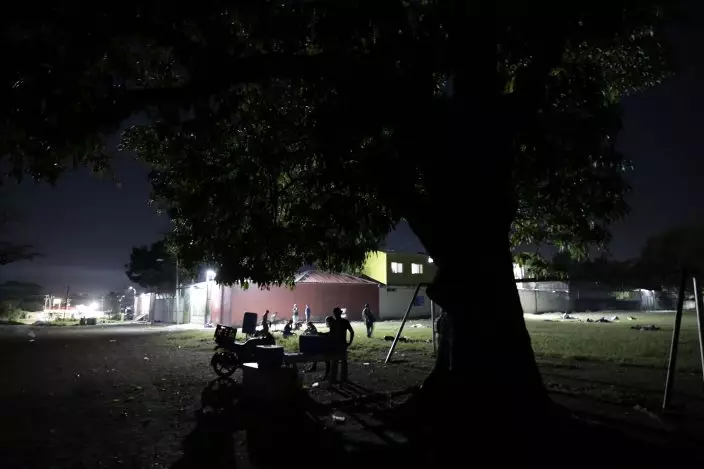
Migrants relax under a tree outside "La 72" migrant shelter in Tenosique, Tabasco state, Mexico, Wednesday, March 24, 2021. (AP PhotoEduardo Verdugo)
Within an hour there were more than 100 migrants at the river’s edge. They were mostly from Honduras, many women with children barely old enough to walk.
They were led onto boats powered with outboard motors, everything organized and out in the open. When they reached the other side, only Mexico lay between them and the U.S. border.
More than two dozen taxis awaited, packed cabs leaving and empty ones returning. Those travelling with guides got into cabs and disappeared into the Mexican countryside. Those without guides or money, like Ponce, walked up the road.

Migrants disembark on the Mexican side of the border after crossing the Usumacinta River from Guatemala, in Frontera Corozal, Chiapas state, Mexico, Wednesday, March 24, 2021. (AP PhotoEduardo Verdugo)
As in 2019, Mexico relies heavily on checkpoints on highways transiting its narrow southern isthmus to prevent migrants heading north. It stepped up those efforts this week, as well as at airports in the region.
The more than 31,000 migrants the government has tallied so far this year roughly mirror the numbers from early 2019, before Trump forced Mexico to act. But Mexico’s migrant detention numbers are more a sign of the government’s effort than a reliable representation of the overall migration flow.
Much of that traffic becomes clandestine in Mexico as smugglers pack migrants into semi-trailers and vans or put them on buses or airplanes with fake documents. Often they only reappear at the U.S. border.
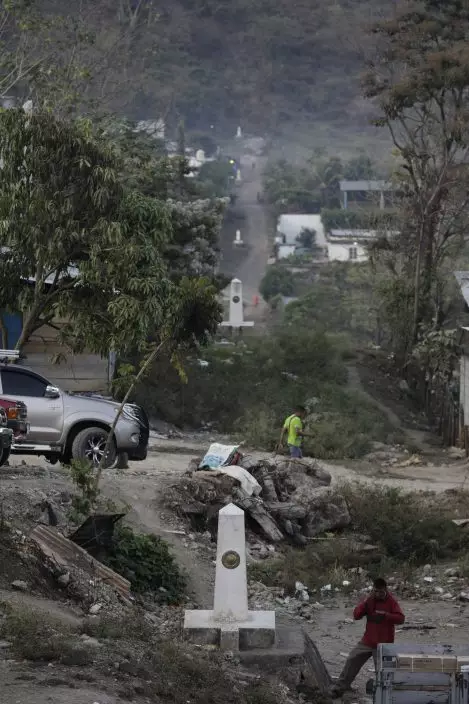
A line of markers indicates the border between La Mesilla, Guatemala, left, and Las Champas Mexico, two towns that sit side by side on Mexico's southern border, Tuesday, March 23, 2021. (AP PhotoEduardo Verdugo)
“The migrants are visible on the Guatemala side, but become invisible crossing into Mexico,” said the Rev. René Sop Xivir of Jesuit Immigrant Services, which serves migrants at the southern border.
On Sunday, even as more than 1,200 migrants crossed at this remote jungle outpost, dozens of Mexican immigration officials waited on the banks of the Suchiate River 300 miles away, facing news cameras as they turned back mostly Guatemalan shoppers with no intention of migrating.
That show of purpose came just before a visit Tuesday by U.S. President Joe Biden’s top immigration advisers, seeking to address the growing problem at the U.S. border.

Migrants eat their dinner in the chapel of "La 72" migrant shelter in Tenosique, Tabasco state, Mexico, Wednesday, March 24, 2021. (AP PhotoEduardo Verdugo)
“They want to pretend they are doing operations, for the press,” Sop Xivir said. “It’s an intimidation campaign so that the people won’t come, because in practice there isn’t much control.”
During a nearly 400-mile trip along the Mexico-Guatemala border, Associated Press journalists saw two National Guard patrols and seven military outposts — ranging from unmanned highway checkpoints to army bases, mainly holdovers from the 1994 Zapatista rebel uprising, that look for weapons and drugs, not migrants.
Sop Xivir said one of the crossings most used by families is called Gracias a Dios — “Thanks to God” — on the Guatemalan side.
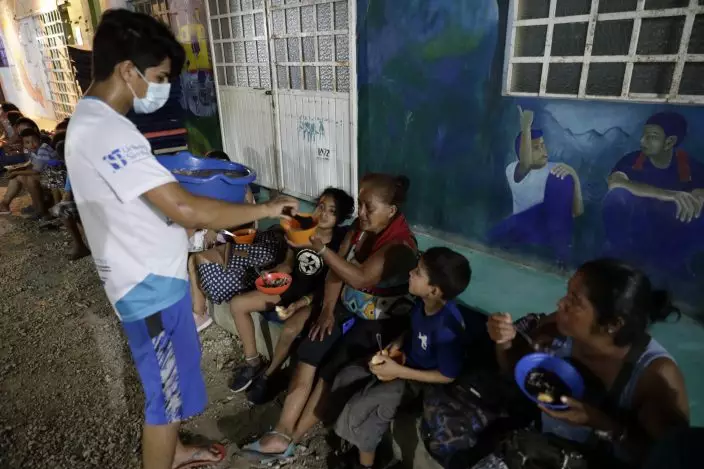
Migrants eat their dinner outside "La 72" migrant shelter in Tenosique, Tabasco state, Mexico, Wednesday, March 24, 2021. (AP PhotoEduardo Verdugo)
“The whole town lives from crossing migrants — the smugglers, the restaurants, the hotels, everything,” said a Gracias a Dios resident, who requested anonymity to avoid reprisals. “Look how much construction there is and the wads of cash that you see in the bank.”
The traffic had slowed significantly in 2020 due to the pandemic, but now it’s like early 2019 all over again, she said. “A few days ago, in a half-hour ... we saw hundreds walking along a mountain path."
Uncontrolled crossings dot Mexico’s southern border. In some, like La Mesilla, residents set up a street market on both sides of the border three days a week. In others, there is just a customs booth surrounded by dirt roads crisscrossing the jungle.

People travel across the Suchiate River, the natural border between Guatemala and Mexico, from Guatemala to Mexico, as Mexican immigration agents enforce limits on all but essential travel at its shared border, near Ciudad Hidalgo, Mexico, Monday, March 22, 2021. Mexican agents are forcing those with permission to enter Mexico to use the official border crossing bridge and others are being returned to Guatemala. (AP PhotoEduardo Verdugo)
At El Ceibo, where the head of Mexico’s immigration agency was photographed this week reviewing operations, there is just a highway. Four days before he visited, two migrants paid $5 to cross there on a motorcycle without anyone asking them for documents.
Among the most vexing issues for the Biden administration, as it was for Trump in 2019 and President Barack Obama in 2014, is the sheer number of unaccompanied children arriving at the U.S. border.
According to statistics published by U.S. Customs and Border Protection, authorities encountered 9,457 children without a parent in February, a 61% increase from January.

Migrants cross the Usumacinta River aboard motor boats into Mexico from Guatemala, in Frontera Corozal, Chiapas state, Mexico, Wednesday, March 24, 2021. (AP PhotoEduardo Verdugo)
About 100 miles up the road from Frontera Corozal, 16-year-old Evinson rested at a migrant shelter in Tenosique. He had walked for two days through jungle-covered hills to get around the official crossing at El Ceibo.
The tall, lanky Honduran teen said he was trying to reach a cousin in New York. Someone at the Texas-Mexico border awaited him to help make that reunion possible, he said.
“I came because the gangsters chased me out, because they extort people and they gave me 48 hours to leave,” Evinson said, asking to not use his surname because he feared for his safety.
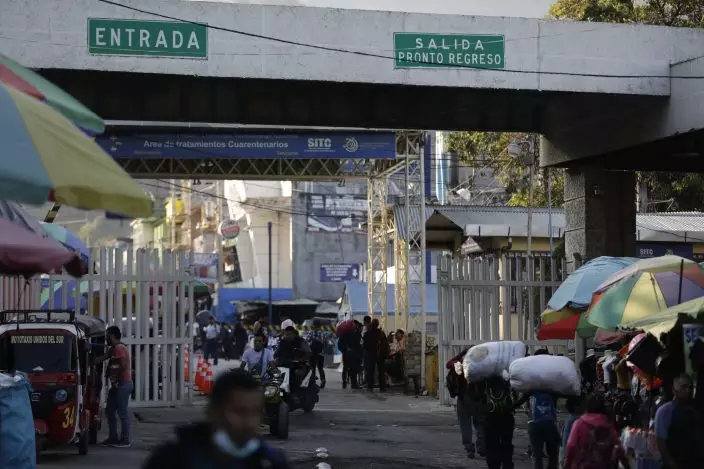
People use the official border crossing into La Mesilla, Guatemala, from Las Champas Mexico, Tuesday, March 23, 2021. (AP PhotoEduardo Verdugo)
A false rumor gave him hope it would all work out, he said, repeating what he'd heard: The U.S. government “was giving 90 days for unaccompanied minors to pass.”

A person carries crates of yogurt cups past a marker that indicates the border between La Mesilla, Guatemala, left, and Las Champas Mexico, two towns that sit side by side, Tuesday, March 23, 2021. (AP PhotoEduardo Verdugo)
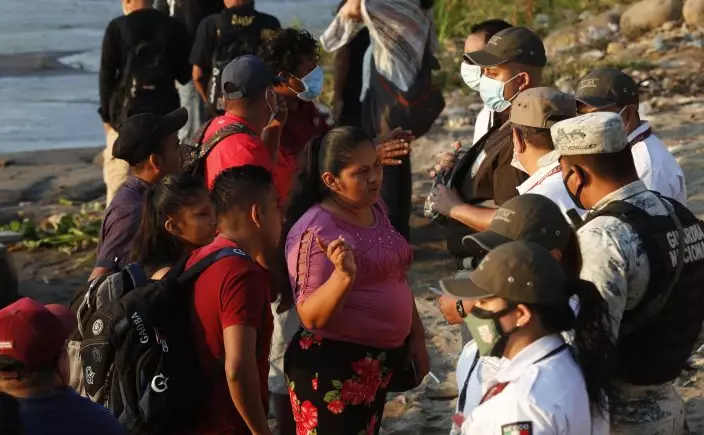
Mexican immigration agents stop people who crossed the Suchiate River, the natural border between Guatemala and Mexico, to see their identification documents as they enforce limits on all but essential travel near Ciudad Hidalgo, Mexico, Monday, March 22, 2021. Agents are forcing those with permission to enter Mexico for work or a visit to use the official border crossing bridge and others are being returned to Guatemala. (AP PhotoEduardo Verdugo)
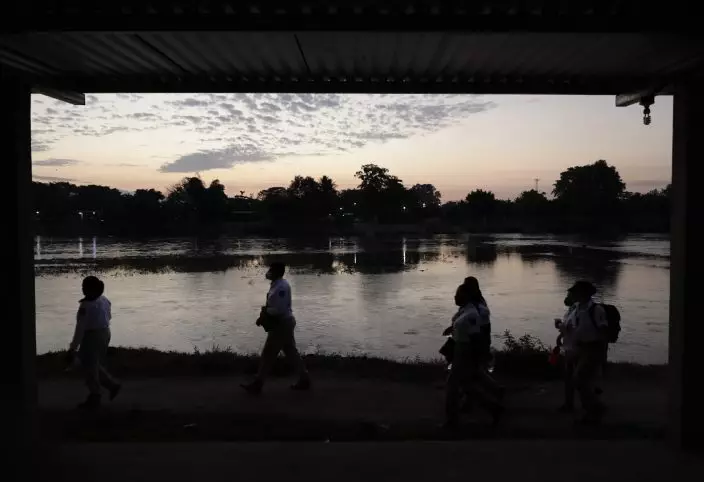
Mexican immigration agents walk towards an access point to the Suchiate River, the natural border between Guatemala and Mexico, near Ciudad Hidalgo, Mexico, Monday, March 22, 2021. Agents are enforcing new limits on all but essential travel at its shared border with Guatemala. (AP PhotoEduardo Verdugo)


